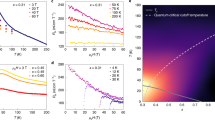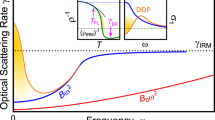Abstract
A strange-metal state appears in many strongly correlated materials, so understanding its nature is a crucial problem in condensed matter physics. This knowledge could provide important insight into high-temperature superconductivity and quantum criticality, but standard Fermi-liquid theory fails in strange metals. Establishing an alternative theory has been a long-standing challenge and fundamental aspects of strange metals—including the nature of their charge carriers—remain elusive. Here we report the observation of a large Nernst response in the strange-metal state in a two-dimensional superconductor 2M-WS2. Specifically, when the system enters the strange-metal state from the Fermi-liquid state, the Nernst coefficient increases to be comparable to the vortex Nernst signal in superconducting cuprates, and it is highly sensitive to carrier mobility. The temperature and magnetic field dependence of the Nernst peak rule out the relevance of both Landau quasiparticles and superconductivity. Instead, the Nernst peak at the crossover indicates a change in carrier entropy when entering the strange-metal state. The presence of such an anomalous Nernst response is further confirmed in other iconic strange metals, suggesting its universality and places experimental constraints on the mechanism of strange metals.
This is a preview of subscription content, access via your institution
Access options
Access Nature and 54 other Nature Portfolio journals
Get Nature+, our best-value online-access subscription
$29.99 / 30 days
cancel any time
Subscribe to this journal
Receive 12 print issues and online access
$209.00 per year
only $17.42 per issue
Buy this article
- Purchase on Springer Link
- Instant access to full article PDF
Prices may be subject to local taxes which are calculated during checkout




Similar content being viewed by others
Data availability
Source data are provided with this paper. Other data that support the plots within this paper and other findings of this study are available from the corresponding author upon reasonable request.
References
Landau, L. D. & Pomeranschuk, I. Y. On properties of metals at very low energies. J. Exp. Theor. Phys. 7, 379–385 (1937).
Baber, W. G. & Mott, N. F. The contribution to the electrical resistance of metals from collisions between electrons. Proc. R. Soc. A 158, 383–396 (1937).
Stewart, G. R. Non-Fermi-liquid behavior in d- and f-electron metals. Rev. Mod. Phys. 73, 797–855 (2001).
Greene, R. L., Mandal, P. R., Poniatowski, N. R. & Sarkar, T. The strange metal state of the electron-doped cuprates. Annu. Rev. Condens. Matter Phys. 11, 213–229 (2020).
Yuan, J. et al. Scaling of the strange-metal scattering in unconventional superconductors. Nature 602, 431–436 (2022).
Abdel-Jawad, M. et al. Anisotropic scattering and anomalous normal-state transport in a high-temperature superconductor. Nat. Phys. 2, 821–825 (2006).
Husain, A. A. et al. Coexisting Fermi liquid and strange metal phenomena in Sr2RuO4. Preprint at arXiv:2007.06670 (2020).
Hussey, N. E. et al. Normal-state magnetoresistance of Sr2RuO4. Phys. Rev. B 57, 5505–5511 (1998).
Hayes, I. M. et al. Scaling between magnetic field and temperature in the high-temperature superconductor BaFe2(As1−xPx)2. Nat. Phys. 12, 916–919 (2016).
Čulo, M. et al. Putative Hall response of the strange metal component in FeSe1-xSx. Phys. Rev. Res. 3, 023069 (2021).
Shen, B. et al. Strange-metal behaviour in a pure ferromagnetic Kondo lattice. Nature 579, 51–55 (2020).
Prochaska, L. et al. Singular charge fluctuations at a magnetic quantum critical point. Science 367, 285–288 (2020).
Cao, Y. et al. Strange metal in magic-angle graphene with near Planckian dissipation. Phys. Rev. Lett. 124, 076801 (2020).
Yang, C. et al. Signatures of a strange metal in a bosonic system. Nature 601, 205–210 (2022).
Hartnoll, S. A. Theory of universal incoherent metallic transport. Nat. Phys. 11, 54–61 (2015).
Patel, A. A. & Sachdev, S. Theory of a Planckian metal. Phys. Rev. Lett. 123, 066601 (2019).
Faulkner, T., Iqbal, N., Liu, H., McGreevy, J. & Vegh, D. Strange metal transport realized by gauge/gravity duality. Science 329, 1043–1047 (2010).
Ayres, J. et al. Incoherent transport across the strange-metal regime of overdoped cuprates. Nature 595, 661–666 (2021).
Deng, X. et al. How bad metals turn good: spectroscopic signatures of resilient quasiparticles. Phys. Rev. Lett. 110, 086401 (2013).
Xu, W., Haule, K. & Kotliar, G. Hidden Fermi liquid, scattering rate saturation, and Nernst effect: a dynamical mean-field theory perspective. Phys. Rev. Lett. 111, 036401 (2013).
Behnia, K. & Aubin, H. Nernst effect in metals and superconductors: a review of concepts and experiments. Rep. Prog. Phys. 79, 046502 (2016).
Behnia, K. The Nernst effect and the boundaries of the Fermi liquid picture. J. Phys. Condens. Matter 21, 113101 (2009).
Xu, Z. A., Ong, N. P., Wang, Y., Kakeshita, T. & Uchida, S. Vortex-like excitations and the onset of superconducting phase fluctuation in underdoped La2-xSrxCuO4. Nature 406, 486–488 (2000).
Wang, Y., Li, L. & Ong, N. P. Nernst effect in high-Tc superconductors. Phys. Rev. B 73, 024510 (2006).
Cyr-Choinière, O. et al. Enhancement of the Nernst effect by stripe order in a high-Tc superconductor. Nature 458, 743–745 (2009).
Fang, Y. Q. et al. Discovery of superconductivity in 2M WS2 with possible topological surface states. Adv. Mater. 31, 1901942 (2019).
Li, Y. W. et al. Observation of topological superconductivity in a stoichiometric transition metal dichalcogenide 2M-WS2. Nat. Commun. 12, 2874 (2021).
Yuan, Y. H. et al. Evidence of anisotropic Majorana bound states in 2M-WS2. Nat. Phys. 15, 1046–1051 (2019).
Chien, T. R., Wang, Z. Z. & Ong, N. P. Effect of Zn impurities on the normal-state Hall angle in single-crystal YBa2Cu3-xZnxO7-δ. Phys. Rev. Lett. 67, 2088–2091 (1991).
Ando, Y., Kurita, Y., Komiya, S., Ono, S. & Segawa, K. Evolution of the Hall coefficient and the peculiar electronic structure of the cuprate superconductors. Phys. Rev. Lett. 92, 197001 (2004).
Coleman, P., Schofield, A. J. & Tsvelik, A. M. How should we interpret the two transport relaxation times in the cuprates? J. Phys. Condens. Matter 8, 9985–10015 (1996).
Anderson, P. W. Hall effect in the two-dimensional Luttinger liquid. Phys. Rev. Lett. 67, 2092–2094 (1991).
Ding, W., Žitko, R. & Shastry, B. S. Strange metal from Gutzwiller correlations in infinite dimensions: transverse transport, optical response, and rise of two relaxation rates. Phys. Rev. B 96, 115153 (2017).
Shastry, B. S. & Perepelitsky, E. Low-energy physics of the t−J model in d = ∞ using extremely correlated Fermi liquid theory: cutoff second-order equations. Phys. Rev. B 94, 045138 (2016).
Perepelitsky, E. et al. Transport and optical conductivity in the Hubbard model: a high-temperature expansion perspective. Phys. Rev. B 94, 235115 (2016).
Ding, W., Žitko, R., Mai, P., Perepelitsky, E. & Shastry, B. S. Strange metal from Gutzwiller correlations in infinite dimensions. Phys. Rev. B 96, 054114 (2017).
Shastry, B. S. & Mai, P. Aspects of the normal state resistivity of cuprate superconductors. Phys. Rev. B 101, 115121 (2020)..
Behnia, K. Fundamentals of Thermoelectricity (Oxford Univ. Press, 2014).
Sondheimer, E. H. & Wilson, A. H. The theory of the galvanomagnetic and thermomagnetic effects in metals. Proc. R. Soc. A 193, 484–512 (1948).
Wang, Y. et al. Onset of the vortexlike Nernst signal above Tc in La2-xSrxCuO4 and Bi2Sr2-yLayCuO6. Phys. Rev. B 64, 224519 (2001).
Xu, X. F. et al. Band-dependent normal-state coherence in Sr2RuO4: evidence from Nernst effect and thermopower measurements. Phys. Rev. Lett. 101, 057002 (2008).
Hohenadler, M. & Assaad, F. F. Fractionalized metal in a Falicov-Kimball model. Phys. Rev. Lett. 121, 086601 (2018).
Gourgout, A. et al. Seebeck coefficient in a cuprate superconductor: particle-hole asymmetry in the strange metal phase and Fermi surface transformation in the pseudogap phase. Phys. Rev. X 12, 011037 (2022).
Mao, Z. Q., Mori, Y. & Maeno, Y. Suppression of superconductivity in Sr2RuO4 caused by defects. Phys. Rev. B 60, 610–614 (1999).
Acknowledgements
We acknowledge useful discussions with T. Leggett, B. S. Shastry, X. Lin, Y. Liu, H. Zhang and H. Zeng. This work was supported by the National Key Projects for Research & Development of China (grant no. 2019YFA0308602 to H.X. and Z.-A.X.), National Natural Science Foundation of China (grant nos. 11804220 to H.X., 12174334 to Z.-A.X. and 52103353 to Y.F.), Natural Science Foundation of Shanghai (grant no. 20ZR1428900 to H.X.) and the Key Research & Development Program of Zhejiang Province, China (grant no. 2021C01002 to Z.-A.X.).
Author information
Authors and Affiliations
Contributions
H.X. conceived the project. H.X. and Z.-A.X. supervised the experiments. Y.Y. and H.X. performed the electron transport and thermoelectric transport measurements with assistance from G.T., C.Y., X.Y., Q.T., C.J., X.X. and Z.-A.X. Y.F. and F.H. grew and characterized the 2M-WS2 single crystals. Y.W. and Z.M. grew and characterized the Sr2RuO4 single crystals. W.D. provided theoretical support. H.X. wrote the manuscript with input from all of the coauthors.
Corresponding authors
Ethics declarations
Competing interests
The authors declare no competing interests.
Peer review
Peer review information
Nature Physics thanks Peizhi Mai, Kamran Behnia and the other, anonymous, reviewer(s) for their contribution to the peer review of this work.
Additional information
Publisher’s note Springer Nature remains neutral with regard to jurisdictional claims in published maps and institutional affiliations.
Supplementary information
Supplementary Information
Supplementary Figs. 1–16 and Discussion.
Source data
Source Data Fig. 1
Electron transport measurement source data for Fig. 1.
Source Data Fig. 2
Thermoelectric transport measurement source data for Fig. 2.
Source Data Fig. 3
Thermoelectric transport measurement source data for Fig. 3.
Source Data Fig. 4
Electron transport and thermoelectric transport measurement source data for Fig. 4.
Rights and permissions
Springer Nature or its licensor (e.g. a society or other partner) holds exclusive rights to this article under a publishing agreement with the author(s) or other rightsholder(s); author self-archiving of the accepted manuscript version of this article is solely governed by the terms of such publishing agreement and applicable law.
About this article
Cite this article
Yang, Y., Tao, Q., Fang, Y. et al. Anomalous enhancement of the Nernst effect at the crossover between a Fermi liquid and a strange metal. Nat. Phys. 19, 379–385 (2023). https://doi.org/10.1038/s41567-022-01904-5
Received:
Accepted:
Published:
Issue Date:
DOI: https://doi.org/10.1038/s41567-022-01904-5
This article is cited by
-
Thermo-electric transport of dyonic Gubser-Rocha black holes
Journal of High Energy Physics (2024)
-
Probes to entropy flow in strange metals
Nature Physics (2023)



